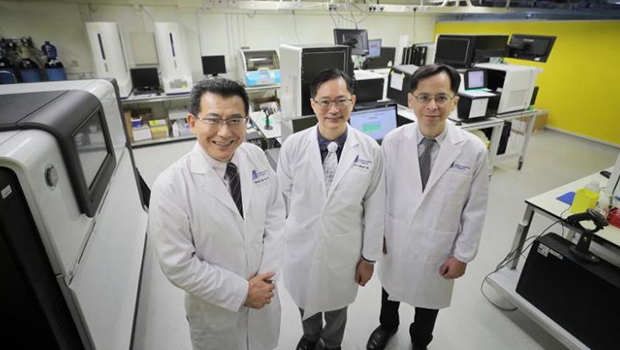
(From left) Professor Liu Jianjun, deputy executive director and senior group leader (human genetics) at the Genome Institute of Singapore (GIS); Professor Patrick Tan, GIS executive director; and Professor Cheng Ching-Yu, principal clinician scientist at the Singapore National Eye Centre’s Singapore Eye Research Institute, with their genome sequencing equipment at the GIS.ST PHOTO: GAVIN FOO
SINGAPORE - Researchers in Singapore have created the world's largest genetic databank of Asian populations, which could help scientists and doctors better diagnose rare diseases, find the causes of chronic ailments and help us better understand the country's history.
The study contains the completed whole-genome sequencing data of around 5,000 Singaporeans, and was published in top biomedical journal Cell on Thursday (Oct 17).
Professor Patrick Tan, executive director at the Agency for Science, Technology and Research's Genome Institute of Singapore (GIS), said on Monday that the project, whose planning began around four years ago, was started partially in response to pressures on Singapore's healthcare system.
Prof Tan, who is also director at the SingHealth Duke-NUS Institute of Precision Medicine (Prism), said: "We can think about the use of data... to be able to identify who's at most risk of developing chronic disease and by doing so mitigate future healthcare costs, (and) who will best respond to a particular therapy so we can allocate the right drugs to the right patients at the right time."
As genetics play a role in determining one's health, data about a patient's genome can enable precision medicine, he added.
Unfortunately, there is a lack of Asian genetic data in public databases around the world.
When researchers try to apply data based on one ethnic group to another, it reduces the accuracy of health-related predictions.
Prism's deputy director (clinical) Saumya Shekhar Jamuar cited a case in the United States where patients were wrongly diagnosed with a heart condition because a variant in their genes did not exist among the American population.
But the variant was actually common among people of African descent and did not cause disease.
The misdiagnosis not only affected the patients but also their siblings, who underwent surgery to insert pacemakers under the mistaken belief that they were at risk of sudden death.
Dr Saumya said: "Wrong genomic data or lack of such data leads to misdiagnosis and misinterpretation."
Fortunately, Singapore is well-placed to fill the gaps in Asian data, said Prof Tan.
The country's three major ethnic groups - Chinese, Malay and Indian - capture around 80 per cent of Asia's diversity.
So in 2017 researchers from GIS and various institutions under the National University Health System, SingHealth and the National Healthcare Group worked together to study the genes of 2,780 Chinese, 903 Malay and 1,127 Indian volunteers.
The study also tapped on data collected from other studies over the past 15 years.
The team identified 98.3 million genetic variants across the Singapore genomes, more than half of which had not previously been reported in public databases.
Professor Tai E Shyong of the Yong Loo Lin School of Medicine and Saw Swee Hock School of Public Health said: "These novel variants present a unique opportunity to make observations that cannot be made in other populations, where they are not present.
"In turn, they allow us to develop new ways to predict diseases and potentially identify new ways to treat or prevent them."
The study also found 14 loci, or spots on chromosomes where genes are located, associated with various traits and diseases.
These have the potential to explain why certain phenomena, such as Asian flush are more or less common among Asians, said GIS' deputy executive director and senior group leader (human genetics) Liu Jianjun.
Asian flush refers to the phenomenon when someone's face turns red after drinking alcohol which is common among Asians of Chinese, Japanese and Korean descent.
The study's implications were not only medical, but historical and anthropological as well.
It revealed some genetic intermingling among the ethnic groups, of which Chinese and Malays were found to be more closely related.
Such information can be used to support existing evidence for human expansion patterns, said Prof Liu.
The data from the study will be deposited in international archives, where researchers from around the world can request access to it.
Prof Liu said the database's creation was a proud moment for Singapore.
He said: "It's not only important for Singapore, but all countries in Asia as well... it's truly a big milestone for us.
"Now, we have a map. Different groups can pick up the map and study it in more detail, read and interpret it."













 Get it on Google Play
Get it on Google Play